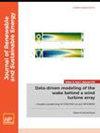2- 乙基己基硝酸酯和乙醇在柴油混合燃料中对环境和性能的影响:综合研究
IF 1.9
4区 工程技术
Q4 ENERGY & FUELS
引用次数: 0
摘要
本研究调查了使用乙醇和石油柴油的混合物(以 2-EHN(2-乙基己基硝酸酯)作为十六烷值改进剂)作为燃料的压燃式发动机的性能和排放情况。实验分析了三种混合燃料(E20(20% 乙醇和 80% 柴油)、E20A(20% 乙醇、0.1% 2-EHN 和 79.9% 石油柴油)、E20B(20% 乙醇、0.2% 2-EHN 和 79.8% 石油柴油))和石油柴油的制动热效率 (BTHE)、特定燃料消耗量、净放热率、指示热效率以及一氧化碳 (CO)、二氧化碳 (CO2)、碳氢化合物 (HC) 和氮氧化物的排放量。实验在不同负载条件和 16.5 压缩比下进行。结果表明,在空载条件下,与 E20、E20A 和 E20B 相比,石油柴油的指示功率(IP)更高。然而,在满负荷条件下,与石油柴油、E20 和 E20A 相比,混合燃料 E20B 的指示功率更高。在压缩比为 16.5 时,混合燃料 E20B 的 BTHE 最高,为 27%,而石油柴油在满负荷条件下的 BTHE 为 25%,因此混合燃料 E20B 的性能更好。然而,在较高负荷和压缩比为 16.5 时,E20A 和 E20B 混合物在所有负荷条件下的 CO、HC、CO2 和 NOx 排放量都明显高于柴油和 E20。具体来说,在满负荷和压缩比为 16.5 的条件下,每种燃料的排放量如下:E20、E20A 和 E20B 的 CO 排放量约为 0.01%,远低于石油柴油(0.1%);E20(15 ppm)、E20A(17 ppm)和 E20B(10 ppm)的 HC 排放量远高于石油柴油(2.5 ppm);E20、E20A 和 E20B 的二氧化碳排放量比石油柴油(15%)少约 13%;E20、E20A 和 E20B 的氮氧化物排放量约为 150 ppm,与石油柴油(140 ppm)相当。这些结果表明,在柴油发动机中使用添加 2-EHN(十六烷值改进剂)的乙醇混合替代燃料需要进一步改进,以减少排放并提高性能。本文章由计算机程序翻译,如有差异,请以英文原文为准。
Environmental and performance impacts of 2-ethylhexyl nitrate and ethanol in diesel blends: A comprehensive study
This study investigates the performance and emissions of a compression ignition engine fueled with blends of ethanol and petroleum diesel with 2-EHN (2 ethylhexyl nitrate) as a cetane improver. Three blends, named E20 (20% ethanol with 80% diesel), E20A (20% ethanol, 0.1% 2-EHN, and 79.9% petroleum diesel), E20B (20% ethanol, 0.2% 2-EHN, and 79.8% petroleum diesel), and petroleum diesel were analyzed for their brake thermal efficiency (BTHE), specific fuel consumption, net heat release rate, indicated thermal efficiency, and emissions of carbon monoxide (CO), CO2, hydrocarbon (HC), and NOx. The experiments were conducted at variable loading conditions and at compression ratio of 16.5. Results showed that at no load conditions, petroleum diesel exhibited higher indicated power (IP) compared to E20, E20A, and E20B. However, at full load conditions, blend E20B showed higher IP compared to petroleum diesel, E20, and E20A. The blend E20B at a compression ratio of 16.5 showed the highest BTHE of 27%, compared to petroleum diesel (25%) under full load conditions, making it a better performing fuel. However, at higher loads and compression ratio of 16.5, the blends E20A and E20B exhibited emissions of CO, HC, CO2, and NOx that were significantly higher than diesel and E20 at all load conditions. Specifically, at full load conditions and compression ratio of 16.5, the emissions for each fuel were as follows: CO emission for E20, E20A, and E20B was around 0.01%, much less than petroleum diesel (0.1%); HC emission for E20 (15 ppm), E20A (17 ppm), E20B (10 ppm) was much higher than petroleum diesel (2.5 ppm); CO2 emission for E20, E20A, and E20B was about 13% less than petroleum diesel (15%); and NOx emission for E20, E20A, and E20B was around 150 ppm, comparable with petroleum diesel (140 ppm). These results imply that further improvements are required in using ethanol blended alternate fuel in diesel engines with 2-EHN (cetane improver) to reduce emissions with improved performance.
求助全文
通过发布文献求助,成功后即可免费获取论文全文。
去求助
来源期刊

Journal of Renewable and Sustainable Energy
ENERGY & FUELS-ENERGY & FUELS
CiteScore
4.30
自引率
12.00%
发文量
122
审稿时长
4.2 months
期刊介绍:
The Journal of Renewable and Sustainable Energy (JRSE) is an interdisciplinary, peer-reviewed journal covering all areas of renewable and sustainable energy relevant to the physical science and engineering communities. The interdisciplinary approach of the publication ensures that the editors draw from researchers worldwide in a diverse range of fields.
Topics covered include:
Renewable energy economics and policy
Renewable energy resource assessment
Solar energy: photovoltaics, solar thermal energy, solar energy for fuels
Wind energy: wind farms, rotors and blades, on- and offshore wind conditions, aerodynamics, fluid dynamics
Bioenergy: biofuels, biomass conversion, artificial photosynthesis
Distributed energy generation: rooftop PV, distributed fuel cells, distributed wind, micro-hydrogen power generation
Power distribution & systems modeling: power electronics and controls, smart grid
Energy efficient buildings: smart windows, PV, wind, power management
Energy conversion: flexoelectric, piezoelectric, thermoelectric, other technologies
Energy storage: batteries, supercapacitors, hydrogen storage, other fuels
Fuel cells: proton exchange membrane cells, solid oxide cells, hybrid fuel cells, other
Marine and hydroelectric energy: dams, tides, waves, other
Transportation: alternative vehicle technologies, plug-in technologies, other
Geothermal energy
 求助内容:
求助内容: 应助结果提醒方式:
应助结果提醒方式:


